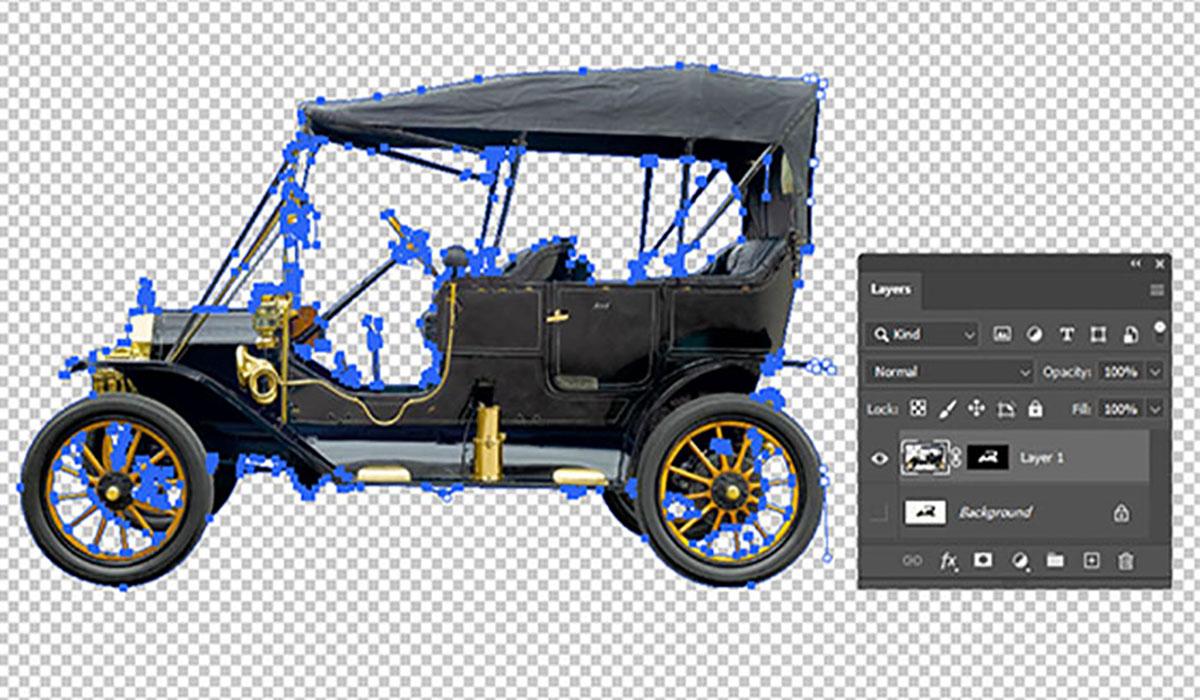
The impact of clipping path technology can be observed in the widespread use of images on social media, where celebrities are often placed within famous artworks or individuals and objects appear to float on solid-colored backgrounds. Programs like Photoshop employ clipping paths to extract objects from digital images for placement onto other digital scenes.
If you've come across amateur attempts at using Photoshop, you may have noticed poorly executed clipping path work, characterized by rough edges and remnants of the original background in the cut-out image. For professionally convincing and seamless editing with clipping paths, it's best to entrust the task to experienced editors like us.
How Clipping Path Works
Within Photoshop, the editor outlines the specific area of the image they intend to use for a new context. The enclosed region is removed, leaving the outer portion to be discarded. Consequently, you can exhibit the extracted image without its original background or place it onto a different backdrop.
Applications of Clipping Path
In some cases, the goal is to showcase an object while concealing the original background. Take, for example, the display of products on ecommerce platforms, often presented without their surroundings. These images aren't captured in midair but are edited using clipping paths. Similarly, brand logos may require background-free images. If you run a blog, searching for suitable images to accompany your content can be time-consuming. Instead, utilizing clipping path techniques to extract specific image components can prove more efficient. Virtually any business that incorporates images, whether it's an ecommerce site, a web design enterprise, or a news platform, can benefit from the use of clipping path services.
Why Outsource Clipping Path Work
Employing clipping path effectively is indeed a specialized skill that requires significant time and practice to master. Considering the complexity involved, dedicating your time to other essential tasks related to managing your website or business would likely yield better results.
Service Complexity of Photoshop Clipping Path?
The significant variation in rates for Photoshop Clipping Path services, even within the same company, can be attributed to the varying levels of complexity in cutting out different images. The difficulty level often determines the time, effort, and expertise required for successful image extraction. While the technology facilitates the extraction of an image from its background, the process becomes more intricate when dealing with images that have complex outlines, such as those used for displaying products on ecommerce platforms or overlaying studio-taken photographs onto diverse backgrounds for magazine covers. Consider the contrast between cutting out a simple triangle from a background and the intricacy involved in removing a lace doily from an image featuring the doily on a differently colored tablecloth. This illustrates the diverse levels of complexity inherent in Photoshop Clipping Path tasks.

Simple/Basic Clipping Path
The process of Simple/Basic Clipping Path primarily involves removing a solid-shaped object from its background. Although the images suitable for this service aren't restricted to simple geometric shapes like triangles, they aren't significantly more complex either. Many products showcased on ecommerce platforms typically require the Basic Clipping Path service. For instance, items such as books and smartphones, which possess rectangular shapes, fall under Basic Clipping Path tasks. On the other hand, objects with both an outer and inner outline, like bracelets or headphones, are considered under Simple Clipping Path tasks. Essentially, if an item has a single hole, displaying both the background outside and inside it, it is categorized as a Simple Clipping Path task. Similarly, items with irregular or curvy outlines but no holes, ensuring a continuous outline, such as T-shirts and trousers, fall under Simple Clipping Path services as well.
Compound Clipping Path
Compound Clipping Path service, also referred to as Medium Clipping Path service, is distinguished by images that contain more negative space or "holes" within the context of Photoshop Clipping Path. These images are notably more complex than those suitable for Simple/Basic Clipping Path. A prime example of an image necessitating Medium Clipping Path is that of an athlete in action. Whether the athlete is captured running, dunking a basketball, mid-jump between a diving board and a swimming pool, or in the moment their pole vault bar touches the ground, there will be irregularly shaped negative spaces. Since human forms are not akin to gingerbread man cookies, unless they are deliberately posing in such a manner, the use of Medium Clipping Path becomes imperative to extract them and incorporate them into a different background.


Complex Clipping Path
Complex Clipping Path is the necessary Photoshop Clipping Path service employed for images that surpass the complexity of Medium Clipping Path images. These images typically feature numerous irregular shapes and multiple areas of negative space. Group photographs, including those with four people striking a pose or larger groups like a color guard with twelve members marching and twirling flags, often require Complex Clipping Path service. Even certain product images for ecommerce sites can be intricate enough to warrant Complex Clipping Path service. A prominent illustration of this complexity is bicycles. Merely outlining the bicycle's silhouette isn't sufficient. To achieve a realistic and enticing appearance for potential buyers, Complex Clipping Path is indispensable for cutting out the intricate negative spaces between the spokes of the wheels.
Super Complicated Clipping Path
Super Complicated Clipping Path service is essential for extracting and editing the most intricate images. Such images often consist of multiple layers, including those with superimposed lettering over multiple figures within a background. Furthermore, photographs capturing people in motion, where individual strands of hair are visibly flying, require Super Complicated Clipping Path service. For instance, if you plan to use an image of your young daughter running against a plain background for this year's family Christmas card, it's advisable to secure her hair in a bun or braid beforehand. Failing to do so would necessitate the use of Super Complicated Clipping Path to detach the image from its original background. Similarly, product images displaying multiple products stacked on top of each other or overlapping also demand Super Complicated Clipping Path service for precise extraction and editing.

Clipping path
A clipping path is a selected outline around an object in a photo, allowing it to be easily integrated into other visuals.
© 2025 ATL. All Rights Reserved.












